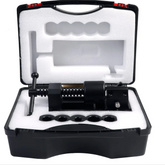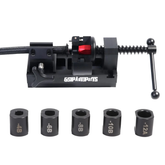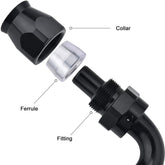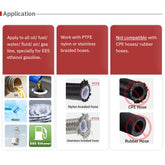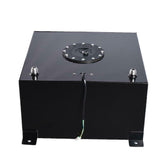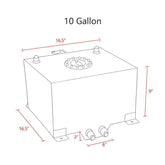What is an EGR Cooler?
Nitrous and oxygen mix at high temperatures to produce nitrous oxide. The chemical connection will be broken by heat in the combustion chamber if it becomes too hot, forming new molecules and releasing NOx into the atmosphere. Automakers have gone to tremendous pains to prevent this because it is one of the most harmful pollutants in the world. Smog, which lowers air quality and can affect those with respiratory disorders, is brought on by nitrous oxide. When combined with water and air, it can also produce acid rain, which is bad for everyone.
The EGR system lowers the temperature of the combustion chamber by diluting the air/gas mixture with inert exhaust gas, which reduces the chances of pollution. However, this might not be sufficient to stave off excessive heat.
So that the EGR system doesn't have to work as hard to prevent NOx, the EGR cooler injects a coolant to lower the temperature of the exhaust gas before it gets recirculated into the engine intake valve.
The EGR valve, which links the engine's intake valve and exhaust valve, is situated between the turbo and cooler. The EGR system circulates gas back into the engine using a hollow tube, or a network of tubes. In close proximity to the EGR valve, the cooler travels through a number of tubes. A wall separating the coolant from the exhaust is permeable to heat. The combustion chamber's temperature will be lowered as a result of the creation of an inert, cool exhaust gas.
Through the EGR valve, the vehicle's onboard computer regulates the EGR cooler. The device automatically distributes coolant based on the combustion chamber's temperature. The heat is subsequently transported to the cooling system of the car, which uses the radiator to dissipate the extra heat.
How do I know if my EGR cooler is failing?
In addition to being essential for lowering emissions, your EGR system controls the temperature of the engine's internal air. It is crucial to maintain this as it stops the engine from overheating. Engine overheating and strange-looking exhaust are signs of an EGR cooler failure.
The condition of your EGR cooler can be determined in four main ways.
1. Smoke or white vapor near the exhaust
Asking a passenger or friend to check this for you is an excellent idea because it could be difficult to watch yourself. Smoke or white steam may indicate an internal coolant leak from the EGR cooler into the EGR system. In the long run, this is bad because the coolant that is passing through boils and is released as a gas. Although there might not be any direct harm to the exhaust system, the engine would overheat due to the decreasing coolant level.
2. Diminished the coolant level without any leaks
As previously said, less coolant is circulating throughout the cooling system when coolant is released as gas. Insufficient coolant can cause air pockets, which would make cooling inefficient. Lower coolant levels suggest there might be an internal cooler issue even in the absence of any obvious leaks.
3. Leakage of external coolant
Your EGR cooler may leak and leave a dried coolant deposit underneath the vehicle or near the leaking site. Because it is frequently visible, diagnosing this may be simpler. Look out for any obvious leaks or low coolant levels.
4. Verify the engine light
The check engine light will frequently come on when the vehicle's ECU detects a difference in the system. When the cooler becomes constrained or stops working properly, it might activate. In any case, you should definitely inspect your engine when you notice the check engine light.
What Causes EGR Failure?
- A crucial component of your engine emissions management system is the EGR cooler. The system won't be able to manage the flow of coolant as the exhaust travels through the EGR valve if your cooler malfunctions. Overheating, the development of pollutants, coolant leakage, and excessive wear and tear could result from this.
- When the engine overworks the EGR valve, EGR coolers degrade. If the exhaust gas gets too hot, which is typically a sign of excessive use, it can wear down the walls of the coolant valve. Due to the breakdown of the coolant-exhaust connection caused by this, the gas returns to the engine at a greater temperature than usual.
- If the EGR valve overpresses the coolant valve, the coolant can also fail. When the EGR valve is closed, the cooler cools the exhaust gas. When the valve is open, the gas reheats. In a typical drive cycle, this occurs repeatedly. The metal inside the cooler expands and stretches against the metal casing each time the valve heats up. The entire system is under pressure as a result.
- The turbo can possibly be contributing to the issue. The amount of boost the engine needs is controlled by the vehicle's computer. Lowering the boost lessens the EGR valve's flow, which relieves pressure on the cooler. Increasing the boost raises the EGR valve's flow, which increases the stress on the cooler.
- High engine soot production will also cause the cooler to fail because it will clog and plug your EGR cooler. Long idling periods and the use of low-sulfur diesel fuel are common causes of this.
- The radiator may also be having problems. The EGR valve will begin to overheat if the car is unable to expel extra heat. Poor ventilation is frequently the cause of this. A bag or article of clothing can be obstructing the radiator.
- Additionally, the EGR cooler may run out of coolant, in which case it becomes completely inoperable.
- The EGR cooler will experience increased heat and pressure from any one or more of these occurrences, raising the likelihood of failure.
How to Prevent EGR Cooler Failure?
Maintaining and cleaning your engine and EGR cooler on a regular basis is the best defense against EGR cooler failure.
Clear the cooler of any soot and other debris that may impede airflow or cause blockage.
If the cooling system in your car is oil-based, the interior of the cooler can also be unclean. You must immerse the component in detergent until the debris dissolves in order to remove and clean the filter. Allow the component to dry after cleaning it before reinstalling.
The easiest way to remove junk from an EGR cooler is to use a dedicated cleaner, but some specialists utilize general purpose cleaners or whatever they can find. When it comes to eliminating carbon buildup, EGR cooler detergents are typically the best; nevertheless, some of these treatments might not work quickly. Never use combustible cleaning supplies inside an engine since they could catch fire.
Prior to reinstalling the part, make sure that all dirt and detergent have been eliminated.

